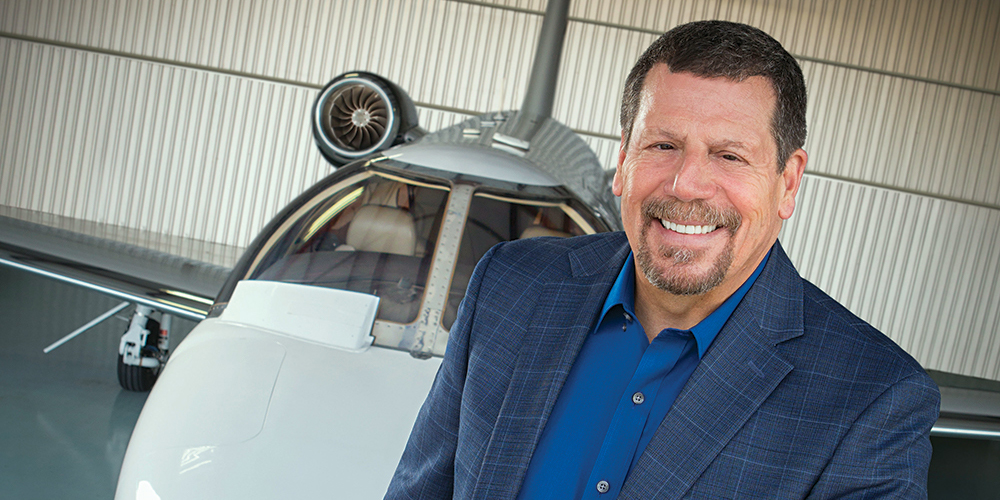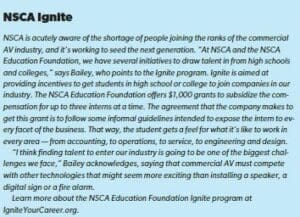Editor’s note: This feature story on Ray Bailey, founder and president of Lone Star Communications originally was published on January 11, 2023. It has since been updated as of April 18, 2023.
At 12 years old, Ray Bailey, the founder and president of Lone Star Communications (LSC), knew exactly what he wanted to do: fly bush planes in Alaska. The Oregon native fulfilled his childhood dream after joining the U.S. Air Force a week after he graduated from high school. While in the Air Force, he specialized in electronics. And, after four years in the military, he flew as a bush pilot in Alaska for six-and-a-half years.
“I ended up going back into electronics and into this industry through a friend who I was in the Air Force with who got out and got into this business,” Bailey recalls. “He said to me, ‘Ray, you’re going to love this. We’re working in schools, [and] we’re doing signaling and emergency paging systems.’” At the time, the Alaska pipeline was being built, and Bailey and the team were doing all the signaling for the living quarters, the pump station, custom panels, etc. “It really was a very interesting industry,” he says, recalling his initial thoughts. “I just fell in love with the business.”
When he’s not in the cockpit, Bailey now charts the course of Grand Prairie, Texas-headquartered LSC, an integration firm whose specialty is life-safety solutions for healthcare. In addition, Bailey serves as president of the Board of Directors of the NSCA.
Working with NSCA
When Bailey started LSC more than 30 years ago, one of the first calls he made was to NSCA, seeking to become a member. It wasn’t until the early 2000s that he decided to get involved on the advisory board. NSCA is, of course, the not-for-profit association representing the commercial integration industry, as well as a key strategic partner of Commercial Integrator’s.
NSCA has come a long way since its inception. Bailey recalls that, when he first joined, it was an association so that those in the industry could gain information about products that were in the market; ultimately, it became an expo, sponsored by manufacturers. Eventually, the association pivoted to what it does today — namely, help integration firms grow their business.
“NSCA became important to my business from the very first day I started LSC,” Bailey recalls. “The Essentials Library, [which is now online,] was absolutely essential for us. Since then, through NSCA, I’ve had people I could share with and talk to about the industry and running a business. I could ask them, ‘What’s your advice on how to do this?’ Everyone was open and willing to share. And that’s the way I have become over the years, as well.” Indeed, as president of the Board of Directors, he’s helping set the vision for the association so it can serve integration businesses well into the future.
“[We’ve really] homed in on the fact that the thing that we’re really good at is helping companies be successful,” Bailey reflects. “And that’s from the smallest companies to the largest companies. We provide information and training about how to be successful in the industry, whether it be from a contractor’s point of view, or an integrator’s point of view, or a solution provider’s point of view.” He adds, “We are there to train and make companies better.”
A Mission for High-Quality Products and Services
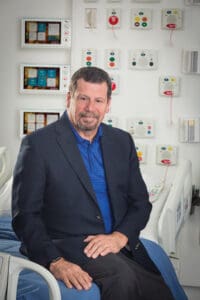
Ray Bailey, founder and president of Lone Star Communications, wanted the organization to be a high-quality one. Thus, he drafted a mission statement that has been its guiding light from the very beginning. that mission statement reads as follows: “We will deliver the right products to our customers on time, the first time, every time, with no exceptions.” Photo by Steve McAlister.
When devising the business plan for LSC in the early ’90s, Bailey decided early on to create a mission statement. Even to this day, the business still adheres to that founding vision.
“There was no regulation back in the early ’90s,” Bailey acknowledges, “so I wanted to be a high-quality organization. I wrote a mission statement, and it reads, ‘We will deliver the right product to our customers — that product can be defined as either service or equipment or both — on time, the first time, every time, with no exceptions.’ [It’s been] our guiding light over the years.”
As part of its mission to deliver high-quality products and services, LSC set out to achieve company-wide ISO certification in the early 2000s. “We wanted to deliver a very high level of quality, and that quality is defined by our own high standards — not anybody else’s standards,” Bailey says. “We set our standards higher than other companies and the industry itself.”
Learning from the Past
With the benefit of three-plus decades as an integration business owner, Bailey has the benefit of hindsight with regard to his own decisions. Recalling early in his career, he describes it as a mistake to have set out to service four distinct markets: education, healthcare, long-term-care facilities and detention centers. “After we started in the first three years, we did all those things,” he describes. “And that was probably one of the bigger mistakes we made because it took us a long time to get started with some of that stuff.”
What Bailey found over time was that, by specializing and becoming good at one thing, LSC would be much more successful. “And that one thing turned out to be education,” he declares. “Between 1991 and 2007, we grew to become the largest Rauland distributor in U.S., selling their education products. We dominated in Texas with what we were selling in 2007.” Later that decade, though, the market took a nosedive, money sources dried up and school funding became scarce. That’s when LSC leaned into the healthcare market, in which it’s still thriving today.
Bailey makes clear that LSC had always been a player in the healthcare market. “We still were doing a lot of hospitals [in 2007],” he notes. “But we weren’t doing near as many dollar-wise as we were in education.” However, after the transition of business focus that year, healthcare grew to become the largest single entity within what LSC does. “As a matter of fact,” Bailey adds, “it’s 87% of what we do as a company. And we’re going to be in excess of $70 million this year.”
Scaling Up
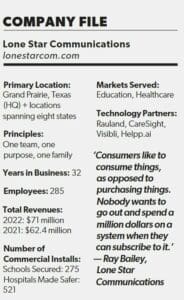 Part of LSC’s success has to do with acquisitions — four of them, to be exact — and the scaling-up principles that Bailey learned from Verne Harnish, founder of Entrepreneurs’ Organization (EO) and author of Scaling Up: How a Few Companies Make It…and Why the Rest Don’t. After hearing him speak at an NSCA event, Bailey purchased Harnish’s book and began applying what he learned. Those principles helped him grow a $26 million business to $71 million in annual revenue this year. Bailey attended a Scaling Up class in Atlanta with his senior staff, and then sent his middle-management team to a one-day Scaling Up class in Dallas. There, his team met with Scaling Up coach Mark Fenner. With Fenner’s help, Bailey put the company on its current trajectory of rapid growth.
Part of LSC’s success has to do with acquisitions — four of them, to be exact — and the scaling-up principles that Bailey learned from Verne Harnish, founder of Entrepreneurs’ Organization (EO) and author of Scaling Up: How a Few Companies Make It…and Why the Rest Don’t. After hearing him speak at an NSCA event, Bailey purchased Harnish’s book and began applying what he learned. Those principles helped him grow a $26 million business to $71 million in annual revenue this year. Bailey attended a Scaling Up class in Atlanta with his senior staff, and then sent his middle-management team to a one-day Scaling Up class in Dallas. There, his team met with Scaling Up coach Mark Fenner. With Fenner’s help, Bailey put the company on its current trajectory of rapid growth.
The first step was to become clear on goals. Every quarter, Bailey completes a one-page strategic plan built around the company’s “Big Hairy Audacious Goal” (BHAG). For LSC, that BHAG is building the team to 1,000 “rising star” employees. The company, which has core values of one team, one purpose and one family, recognized that fostering team unity was essential amid four company acquisitions and having scaled to eight offices. The company also seeks to align the entire team around its purpose: making communities safer. Therefore, LSC conducts regular surveys to understand how employees are feeling and what they want. Bailey has responded to that with continuous company-culture refinements.
A Forever Home
“Over time, what we learned from those surveys is people are looking for places they can stay forever,” Bailey reflects. “What we found is, with the younger crowd, they wanted to know where they would be in five years…what their future would be.”
To build a strong culture, Bailey hired a talent development manager who had experience as a teacher and school principal. The talent development manager’s mission was to talk to all employees and help them discover what their goal was, as well as where they wanted to be in five or 10 years. Then, together, they would lay out a plan to help employees build their education and bolster their résumé to meet these goals.
LSC made another valuable discovery as it acquired companies — namely, not all talent had to be at the main office in Grand Prairie. “As we brought companies together, we found HR strength in Little Rock and payroll expertise in Austin, yet our recruiting is based in Grand Prairie,” Bailey describes. “These employees work together seamlessly to create our corporate HR department. We established working remotely even before COVID-19 forced everyone home, which made working from home a very easy transition for [LSC], resulting in growth even during the pandemic.”
CareSight Acquisition
Speaking of acquisitions, Bailey, recognizing the value of healthcare analytics, sought to acquire one of its own technology partners. In October, the company acquired CareSight, LLC, an alarm analytics-as-a-service company that delivers the information required to help hospitals manage their alarm, alert and notification environments. The acquisition of CareSight positions the company as the only automated, multi-source solution-as-a-service on the market that can deliver actionable data to nursing managers, patient-quality officers and hospital executives. LSC also installs real-time locating systems (RTLS) to locate nurses throughout the day in hospital settings, such as a nurse to tend to a patient in pain.
“You really don’t know how efficient nurses are until you start tracking them using the RTLS system,” Bailey explains. “And you really don’t know how efficient they are until you can look at the nurse-call system. Using the analytic software, we can now correlate every one of these disparate systems, and we can then collate it. And, from that data, we can say that the nurse is accomplishing that task within three minutes.” The imperative for efficiency is ongoing, however. “If we were to change that workflow just a little bit and add on one extra step, or cut out some steps,” Bailey continues, “then we can cut that workflow down to two minutes. And by cutting it down by one minute and doing [that] 30 or 40 times a day, it makes a nurse more efficient.” That’s dozens more minutes that a nurse can spend with their patients, as opposed to answering calls, writing records, etc.
Removing Extraneous Steps
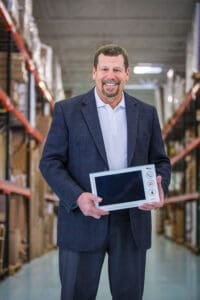
Lone Star Communications partners with Rauland workflow and communications products, such as the Rauland Converge Panel, part of the Responder Enterprise nurse call system (as shown above), for hospital and schools worldwide. With today’s equipment shortage, the company is leaning toward more software and subscription-based systems. Photo by Steve McAlister.
“By making that connection between those points, we can now create a patient record that is written to the electronic medical record (EMR),” Bailey continues. To be specific, formerly, when a medication request was made, a nurse had to stop and record the request, when the meds were administered and the dosage. With CareSight, it’s possible to build that record and send it to the nurse, who can either reword it or accept it as is, and then directly write to the patient’s medical record. Ultimately, it takes steps out of the nurse’s day, leveraging an automated solution so nurses can become more efficient and give better patient care. “It makes the patient much more satisfied,” Bailey enthuses. “They can get the care they want, when they want it.”
Bailey says that LSC’s goal has changed from just providing good signaling for hospitals to improving caregiver workflows and overall patient-stay experiences. “With this analytic software tied to all [different] systems, we now can pull it all together and look at it as a single group of data. And we could truly make some comparisons that we couldn’t make before,” he declares. “This is truly an as-a-service. You can truly turn it on or off. We can set it up at a hospital, they can use it, and, in six months, if it’s not giving them the results they want, they can turn it off.”
Conversely, healthcare operations might find that not only is it giving them the results they want, but, in fact, they want more data. “So,” Bailey says, “then we expand it to other systems within the hospital, as well. It doesn’t matter what system it is — it could be the laundry chute! We could tell you when and how often it’s being used.”
Adding Professional Services
If you would have asked Bailey 30 years ago if he would ever need registered nurses on his staff, he would likely have asked, “What for?” However, with the company having morphed into providing professional services, eight registered nurses work for the company to provide healthcare providers or healthcare facilities with advice.
Any of LSC’s nurses can go into a hospital setting, immediately recognize what’s happening and make projected improvements on workflows.
The results of what LSC does are self-evident. As Bailey puts it, “The patient is more satisfied, [which] adds up in higher reimbursements for [the healthcare institution], so they get more income as a result of that.”
In the coming years, LSC hopes to become known as a national company renowned for its superior professional services throughout the U.S., helping improve the processes within facilities, helping companies and/or facilities become more efficient, and helping healthcare entities provide better patient care. “Ultimately, all that leads to higher reimbursements for the hospital,” Bailey notes. “And that’s really our goal: If we do the [rest], the [last] one will come along naturally.”
Aggressive Growth Targets
When it comes to managed services, LSC is moving aggressively. About 14% of the company’s total revenue is recurring. Bailey has set ambitious growth targets to raise that to 30% over the next three years — and then to 50% over the next 10 years. “I think it’s probably more aggressive than a lot of integrators,” Bailey says. All integrators want to reach those levels, he says, but notes that it’s very hard for integrators still focused on reselling and installing hardware products.
Using the analogy of a car, Bailey says that people don’t “subscribe” to a car — they buy it — and they perhaps might subscribe to a maintenance agreement. LSC is positioned favorably, however, he says, noting, “More and more of what we’re doing is software, and our manufacturers are providing software.” What’s more, with the CareSight acquisition, LSC has its own in-house portfolio. “More and more of it is going to become software and subscription,” Bailey adds. “I’d like to say 100%, but that’s not likely to happen anytime soon.”
From CapEx to OpEx
For Bailey, the conclusion is inescapable: The AV industry needs to roll with the tide of software and subscription-based offerings. “Consumers like to consume things, as opposed to purchasing things,” he declares. “Nobody wants to go out and spend a million dollars on a system when they can subscribe to it and pay a little piece of that every month.” Increasingly, LSC has found that it has been moved from capital expenditure (CapEx) budgeting to operational expenditure (OpEx) budgeting. “It becomes a monthly charge or an annual charge, as opposed to some million-dollar project that they have to collect funds for ahead of time,” Bailey says.
Download: 2022 Software Deep Dive
From Bailey’s vantage point, the future of the AV industry looks bright. “I think there’s a big future [ahead],” he declares. “The AV industry is going through a change, and that is we’re becoming more software and less hardware oriented. I think those companies that are making that change and becoming more of a service entity are going to have a higher success rate and a lot more longevity than those that remain a hardware company.”
Of course, in commercial AV, hardware will never be eliminated completely. There will always be a place for speakers, microphones, etc. But, if you ask Bailey, those products will become more generic, more commodity-based and less specific. “The software, the programming of that software and how you customize that software to fit a customer’s needs is going to become bigger,” he foretells.
For more integrator profile stories like this, subscribe to Commercial Integrator’s monthly print publication.

